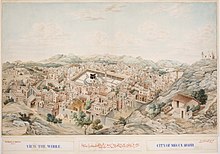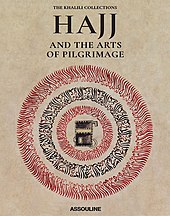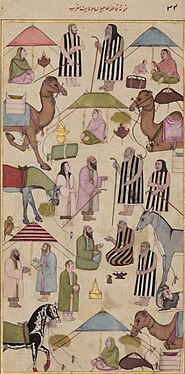Hajj: Journey to the Heart of Islam
 17th- or 18th-century Hajj certificate showing the Kaaba within the Masjid al-Haram | |
| Date | 26 January – 15 April 2012[1] |
|---|---|
| Venue | British Museum |
| Type | Art exhibition |
| Theme | Hajj |
Hajj: Journey to the Heart of Islam was an exhibition held at the
The exhibition was formally opened by
An exhibition catalogue with essays about the hajj, edited by Venetia Porter, was published by the British Museum in 2012, along with a shorter illustrated guide to the hajj. An academic conference, linked to the exhibition, resulted in another book about the topic.
Background: The Hajj

The hajj (
The hajj is one of the
Preparation and launch
There had been no previous major exhibitions devoted to the hajj.
The exhibition was presented in partnership with the
Content

The exhibition was held in the circular
The bulk of the content was organised around three themes: pilgrimage routes, the rituals of the hajj, and Mecca.[22] The first section described five different pilgrimage routes towards Mecca: the traditional routes through Arabia, North Africa, the Ottoman Empire, and Asia, plus the modern route by air from Britain. It thus contrasted the early pilgrims' arduous, risky journey across desert or ocean with the ease of modern travel.[25][11]
Pilgrimages of past centuries were illustrated by manuscripts of hajj-related literature, including the Anis Al-Hujjaj, the Dala'il al-Khayrat, the Shahnameh, the Futuh al-Haramayn, and the Jami' al-tawarikh.[26] Mansa Musa, king of the Mali Empire, travelled to Mecca in 1324 with 60,000 courtiers as atonement for accidentally killing his mother; he was depicted in a panel from a 14th-century Catalan Atlas.[27][5] The importance of Mecca to Muslims was illustrated by these ancient maps and diagrams as well as by qibla compasses which help devotees turn towards the city, which they are required to do for prayer.[24][28]
The stories of individual historical pilgrims were told through diaries and photographs. These included Westerners such as the explorer
A seven-minute video illustrated the rituals of the hajj.
The section on Mecca used past and present photographs and paintings to show how the mosque surrounding the Kaaba (the Masjid al-Haram) has been modernised to make space for much larger numbers of pilgrims, resulting in some ancient buildings being demolished.[25] The 19th-century photographs included some by Muhammad Sadiq of holy sites in Mecca and Christiaan Snouck Hurgronje's portraits of pilgrims.[26]
Towards the end of the exhibition were several pieces of contemporary art, including works by Ahmed Mater, Idris Khan, Walid Siti, Kader Attia, Ayman Yossri, and Abdulnasser Gharem.[31][24][26][29] A final section played audio testimonies of British hajj pilgrims[10] and invited guests to write down their own reflections.[11]
-
Illustration of theProphet's Mosque in Medina from the Dala'il al-Khayrat, late 17th or 18th century
-
Chamfronfor a horse, Ottoman Empire, 18th century
-
Section from the kiswah of the Maqam Ibrahim, Cairo, 19th century
Reception and legacy
The museum's target of 80,000 visitors was quickly exceeded. By the end of the run, 119,948 adult tickets had been sold (children had free entry and were not counted).[10] According to the British Museum's annual report, educational events connected to the exhibition attracted nearly 32,000 participants.[32] Forty-seven percent of visitors were Muslims.[33] Some non-Muslim visitors reported that overhearing Muslim families' conversations or striking up conversations with them, helped them appreciate the spiritual importance of the hajj.[25]
In surveys, 89% of attendees reported emotional or spiritual reactions such as reflection on faith.[34] Steph Berns, a doctoral researcher at the University of Kent, interviewed attendees and found a small minority for whom contemplating the artefacts or personal testimonies induced a sense of closeness to God.[35] The aspects of the exhibition most often remarked on by visitors were the personal accounts of hajj pilgrims in the video, photographs, and textual diaries.[25] The artifacts that attracted the most visitor comments were the textiles and contemporary art pieces.[36] Berns observed that, for most visitors, the exhibition could not fully reproduce the personal and emotional experience of the hajj, which is crucially connected to the specific location of Mecca. She described this as an unavoidable result of presenting the topic within a museum thousands of miles away.[25]
In
The journalist and broadcaster
In
-
Illustration of a North African pilgrim caravan from the Anis Al-Hujjaj, 17th century
-
Mahmal cover in red silk, late 19th century
-
Section from the curtain of the prophet's tomb, 18th century
Publications

Two books resulted directly from the exhibition, both edited by Venetia Porter. Hajj: Journey to the Heart of Islam is an exhibition catalogue that also includes interdisciplinary essays explaining the history, culture, and religious significance of the hajj. The authors include Karen Armstrong,
An academic conference was held in conjunction with the exhibition from 22 to 24 March.[15] Its proceedings, including thirty papers on different aspects of the hajj, were published by the British Museum in 2013 as The Hajj: Collected Essays, edited by Venetia Porter and Liana Saif.[42]
The Khalili Collection of Hajj and the Arts of Pilgrimage subsequently expanded into a five-thousand-object collection documenting the Islamic holy sites of Mecca and Medina. In 2022 it was published in a single illustrated volume by Qaisra Khan, who had co-curated the London exhibition and had become the curator of Hajj and the Arts and Pilgrimage at the Khalili Collections.[43][44] An eleven-volume catalogue is scheduled for publication in 2023.[45]
Related exhibitions
The success of Hajj: Journey to the Heart of Islam prompted museums and art institutions in other countries to inquire about hosting hajj-themed exhibitions. It was not possible for the London exhibition to go on tour; it had involved special loans from 40 different sources, arranged by years of negotiation. Instead, these institutions created exhibitions on the theme of the hajj using items loaned by the Khalili Collection, among other collections.
See also
References
- ^ ISSN 1543-950X.
- ^ a b Piscatori, James (19 January 2012). "Hajj: Journey to the Heart of Islam". Times Higher Education (THE). Retrieved 5 September 2022.
- ^ ISBN 978-0-7614-7926-0. Retrieved 1 March 2021.
- ^ ISBN 0-253-21627-3.
- ^ a b c d Gilbert, Jenny (29 January 2012). "Hajj: Journey to the heart of Islam, British Museum, London". The Independent. Retrieved 2 September 2022.
- ISBN 978-981-230-802-3.
- ISBN 978-978-081-447-2.
- OCLC 758278456.
- ^ Zaki, Yousra (7 August 2019). "What is Hajj? A simple guide to Islams annual pilgrimage". Gulf News. GN Media. Retrieved 1 March 2021.
- ^ a b c d e f g "The Hajj – Journey to the Heart of Islam". Kashmir Observer. 27 September 2012. Retrieved 1 September 2022.
- ^ a b c d e f g h Foulds, Amy (27 February 2012). "Journey to the Heart of Islam". The Diplomat. Retrieved 1 September 2022.
- ^ a b c d Kennedy, Maev (25 January 2012). "Hajj exhibition at British Museum". The Guardian. Retrieved 2 September 2022.
- ^ a b c Akbar, Arifa (20 January 2012). "Pilgrim's progress: Journey to the Heart of Islam". The Independent. Retrieved 6 September 2022.
- ^ Porter 2012, p. 9.
- ^ ISSN 0965-8297.
- ^ Porter 2012, p. 11.
- ^ Porter 2012, pp. 7, 275.
- ^ Moore, Susan (12 May 2012). "A leap of faith". Financial Times. Retrieved 2 September 2022.
- ISSN 0965-8297.
- )
- ^ "A speech by HRH The Prince of Wales at the opening of the "HAJJ: Journey to the heart of Islam" exhibition at the British Museum". Prince of Wales. 26 January 2012. Archived from the original on 5 April 2023. Retrieved 1 September 2022.
- ^ a b "Hajj: Journey to the Heart of Islam". Time Out London. 11 October 2012. Retrieved 1 September 2022.
- ^ a b Khan, Tabish (28 January 2012). "Exhibition Review: Hajj: Journey To The Heart Of Islam @ The British Museum". Londonist. Retrieved 1 September 2022.
- ^ a b c d e Guner, Fisun (21 February 2012). "Hajj: Journey to the Heart of Islam, British Museum". The Arts Desk. Retrieved 1 September 2022.
- ^ S2CID 192190977.
- ^ a b c d e f Porter 2012, pp. 272–275.
- ^ Porter 2012, p. 154.
- ISBN 978-0-19-512558-0. Retrieved 13 March 2023.
- ^ ISSN 0140-0460. Retrieved 5 September 2022.
- ^ a b c Goodwin, Jason (20 February 2012). "The British Museum's 'Hajj: Journey to the Heart of Islam'". Newsweek. Retrieved 1 September 2022.
- ^ a b Jones, Jonathan (25 January 2012). "Hajj: Journey to the Heart of Islam – review". The Guardian. Retrieved 1 September 2022.
- OCLC 1117090767.
- ^ Morris Hargreaves McIntyre & July 2012, p. 5.
- ^ Morris Hargreaves McIntyre & July 2012, p. 9.
- ^ Berns 2015, p. 174.
- ^ Berns 2015, p. 151.
- ^ Sewell, Brian (16 June 2015). "Hajj – journey to the heart of Islam, British Museum – review". Evening Standard. Retrieved 8 December 2022.
- ^ Manzoor, Sarfraz (9 March 2012). "How the British Museum brought the hajj to my mum". The Guardian. Retrieved 2 September 2022.
- ^ Armstrong, Karen (22 January 2012). "Prejudices about Islam will be shaken by this show". The Guardian. Retrieved 2 September 2022.
- ^ Cohen, Nick (18 March 2012). "Keep corrupt regimes out of British culture". The Guardian. Retrieved 2 September 2022.
- ^ Jones, Jonathan (19 March 2012). "The British Museum's Hajj takes us on a pilgrimage, not a propaganda journey". The Guardian. Retrieved 2 September 2022.
- ^ "The Hajj: collected essays". WorldCat. Retrieved 7 December 2022.
- ^ Maisey, Sarah (11 July 2022). "New book shows 300 illustrations of the Hajj pilgrimage over the centuries". The National. Retrieved 6 December 2022.
- ^ "Assouline takes readers to the heart of Hajj in new tome". Arab News. 8 July 2022. Retrieved 22 February 2023.
- ^ "Hajj and The Arts of Pilgrimage". Khalili Collections. Archived from the original on 19 March 2023. Retrieved 6 December 2022.
- ^ a b Mishkhas, Abeer (26 July 2013). "The British Museum's Hajj exhibition inspires Paris, Leiden and Doha". Asharq Al-Awsat. Retrieved 5 September 2022.
- ^ "The Eight Collections". Nasser David Khalili. 8 February 2022. Archived from the original on 4 July 2020. Retrieved 6 December 2022.
- S2CID 221062579.
Sources
- Berns, Steph (2015). "Hajj: Journey to the Heart of Islam" (PDF). Sacred Entanglements: studying interactions between visitors, objects and religion in the museum (PhD). University of Kent. pp. 136–175. Retrieved 2 September 2022.
- Morris Hargreaves McIntyre (2012). "Bridging cultures, sharing experiences: An evaluation of Hajj: journey to the heart of Islam at the British Museum" (PDF). British Museum. Retrieved 7 December 2022.
- Porter, Venetia, ed. (2012). Hajj: Journey to the Heart of Islam. London: British Museum Press. OCLC 745332856.
External links
- Video about the exhibition by The Financial Times
- Gallery of photos from the exhibition, the Khalili Collections






